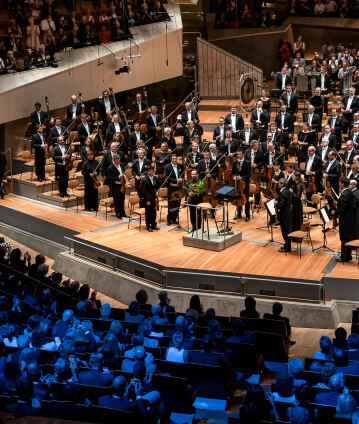Season opening 2022: Kirill Petrenko conducts Mahler’s Seventh Symphony

Kirill Petrenko first conducted Mahler with the Berliner Philharmoniker in 2020 with his Sixth Symphony. For the season opening in 2022, he conducted the Seventh – a piece characterised by night-time moods. “You will rarely hear the work with greater rhythmic precision”, the Frankfurter Allgemeine Zeitung pointed out, and the Tagesspiegel found that the Philharmoniker “played with sheer dizzying bravura, the solos of tenor horn and horn were unparalleled”.
The fact that Gustav Mahler’s Seventh Symphony was overshadowed by his other symphonies for a long time is also reflected in the performance statistics of the Berliner Philharmoniker: as the last of the composer’s completed symphonies, the orchestra first performed it in 1920, and not once between 1930 and 1957.
Five-movement symphonies like Mahler’s Seventh differ from the four-movement standard in one obvious but significant aspect: mirror symmetry places one movement at the centre. Mahler designs that of the Seventh as a short ghostly scherzo, doubly framed by two “Nachtmusiken” and the outer movements. The naming of the symphony as a “Song of the Night”, which is not Mahler’s, does not indicate a gloominess of the soul; rather, it evokes a Romantic atmosphere of nature, mystery and poetry.
If the opening movement already makes an impressive development from a tonally shadowed beginning to optimism, the finale forms the triumphant end point of the work’s dramaturgy. Here, the rondo form allows Mahler to call up a wealth of musical forms – from dances and marches to the operatic – between the refrain-like recurring theme. In the powerful final climax, the main theme of the first movement is taken up again.
Mahler symphonies in season opening concerts of the Berliner Philharmoniker have been a tradition since Claudio Abbado took office – a tradition Kirill Petrenko continues as chief conductor.
© 2022 Berlin Phil Media GmbH
Related interviews
Artists
Our recommendations
- The Berlin Phil Series: Kirill Petrenko live – Serenades
- Kirill Petrenko conducts Beethoven’s Ninth Symphony at the Brandenburg Gate
- 2023 Europakonzert from Barcelona with Kirill Petrenko
- Kirill Petrenko with Strauss’s “Die Frau ohne Schatten” in Baden-Baden
- Kirill Petrenko and Daniel Barenboim
- Kirill Petrenko conducts Tchaikovsky and two world premieres